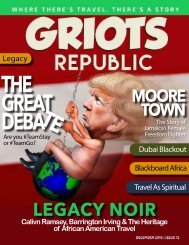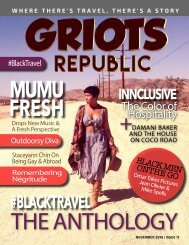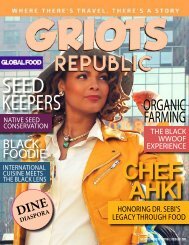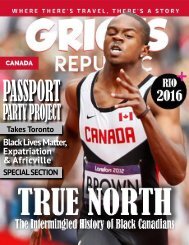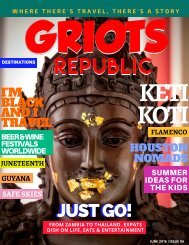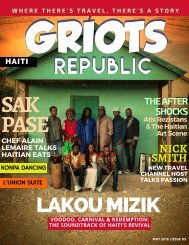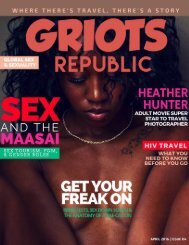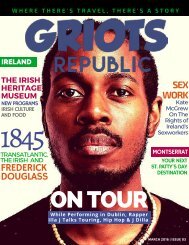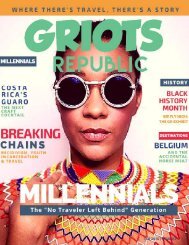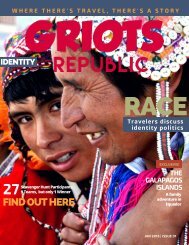GRIOTS REPUBLIC - AN URBAN BLACK TRAVEL MAG - OCTOBER 2016
In the October Issue of Griots Republic we cover GLOBAL DESIGN! From interior to sound design we plug into the subjects that interest urban travelers. Black Travel Profiles include: Brooklyn Circus Founder, Ouigi Theodor. Up In Air Life Founder, Claire Soares. Fashion Influencer, Jason Andrew and Blogger A.V Perkins of A.V Does What. This issue also includes interviews with International D.J., DJ Super Nova and street artist and designer Jerry Gant. This is Black Travel!
In the October Issue of Griots Republic we cover GLOBAL DESIGN! From interior to sound design we plug into the subjects that interest urban travelers. Black Travel Profiles include: Brooklyn Circus Founder, Ouigi Theodor. Up In Air Life Founder, Claire Soares. Fashion Influencer, Jason Andrew and Blogger A.V Perkins of A.V Does What. This issue also includes interviews with International D.J., DJ Super Nova and street artist and designer Jerry Gant. This is Black Travel!
Create successful ePaper yourself
Turn your PDF publications into a flip-book with our unique Google optimized e-Paper software.
THE INTERSECTION OF<br />
ART & CULTURE<br />
By CosmoLatina<br />
What images come to mind<br />
when you hear New Zealand?<br />
For many, Aotearoa, the Maori<br />
name for the South Pacific Land of<br />
the Long White Cloud, is a country of<br />
pristine natural beauty, an adrenaline<br />
junky’s paradise, a lamb lover’s heaven<br />
and thanks to the All Blacks, a rugby<br />
fan’s source of pride. While these are<br />
indeed the images that are exported,<br />
there is another side to the two-island<br />
nation.<br />
The Māori, or indigenous people of<br />
New Zealand, have achieved international<br />
recognition with the haka. Māori<br />
& Pākehā (white New Zealanders)<br />
alike can be seen performing the haka<br />
on rugby fields, at airports and even<br />
at weddings. However, there are more<br />
traditional art forms that remain distinctively<br />
a Māori tradition. One of those is<br />
the tā moko (permanent body & face<br />
markings). While tribal tattoo designs<br />
have increasingly gained popularity,<br />
the tā moko is much more than a cool<br />
way to get some ink on your body. In<br />
fact, the term kirituhi (drawn skin) was<br />
created to refer to Māori designs used<br />
by non-Māori.<br />
Historically, the tā moko was a sign of<br />
someone’s social status, thus not having<br />
one would signify a lower social<br />
status. The placement of the moko was<br />
also significant. Māori culture has traditionally<br />
been very gendered. Everyone<br />
had their role and followed suit accordingly.<br />
Thus, the men have moko on<br />
their mata (face), raperape (buttocks)<br />
& pūhoro (thighs). Women’s moko is<br />
typically on their kauae (lips and chin).<br />
Moko can also be found on other parts<br />
of the body, depending on their rationale,<br />
such as making oneself appear<br />
more attractive to the opposite sex.<br />
Modern day tā moko has gone through<br />
different stages. In the 1970s and 80s<br />
it was associated with Māori gangs and<br />
seen very negatively. By the 1990s, just<br />
a few years after Te Reo Māori became<br />
Aotearoa’s second official language,<br />
tā moko once again became a sign of<br />
cultural pride. Tā moko artist Paitangi<br />
Ostick, shares what it means to carry<br />
on this tradition, “to wear moko kauae<br />
is not only an honor but very humbling.<br />
I wear the cultural identity of the Māori<br />
people so I have become an ambassador<br />
wherever I am in the world.”<br />
Tā moko are more than just designs.<br />
They, like hieroglyphics, tell a story.<br />
Similar to many indigenous communities<br />
around the world, Te Reo Māori,




